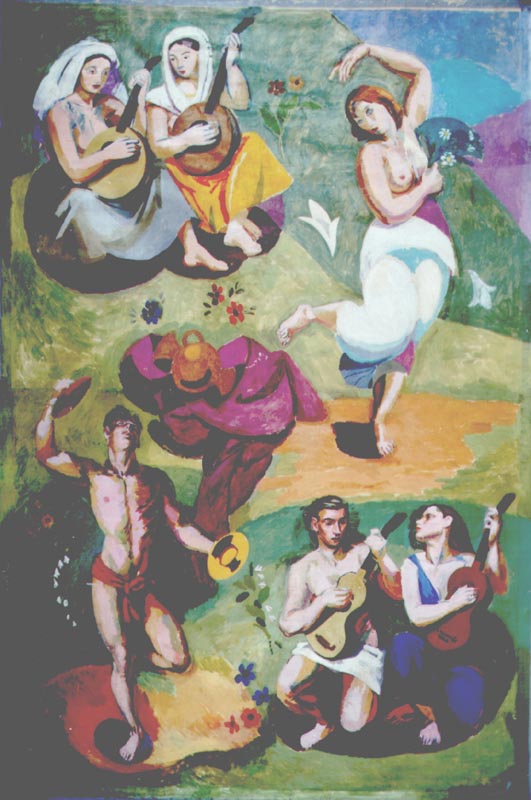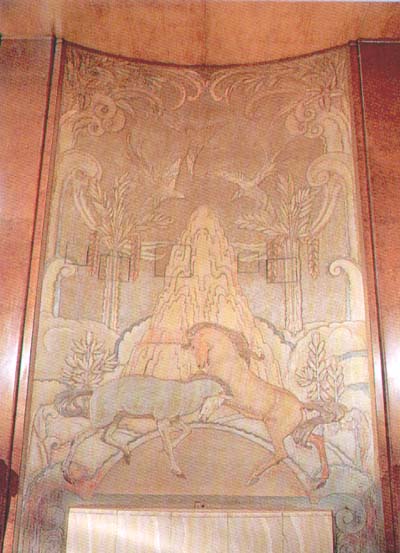Duncan Grant's original plans for the
First Class Lounge.
During the preparations for the fitting out of the
Queen Mary, one of the Directors of the Cunard company wrote to Mr B.W. Morris,
the American architect supervising the general scheme of decoration "If you tell
a decorator one would like something modern in a room, one feels it is
dangerous, because he may feel it incumbent upon him to produce something
striking and unusual".
In the case of the fitting out and decoration of the First
Class Lounge, this statement was to prove all too true, and the appearance of
the room today, and during the Queen Mary's sailing career, is not that
originally proposed by the main artistic contributor to it. In this article, the
designers of this website attempt to give an idea of what the room would have
looked like if the designs had remained unchanged.
After the main layout of the public rooms had been
decided, a list of artists was drawn up who it was thought might be suitable
contributors to the interior design of the Queen Mary. Eventually, in 1935, thirty were
selected from this short-list. It was thought they would all produce art-work
within acceptable boundaries which would fit into an overall artistic plan for
the ship, providing variety but with nothing too bizarre. The artist chosen to
design contributions for the First Class Lounge was the British artist Duncan
Grant. Work was to be completed by 30th November 1935, but his designs were to result in a bitter argument between the Cunard
company and artistic circles in Great Britain.
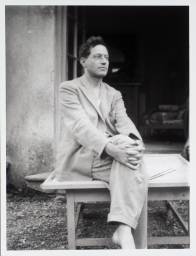 Duncan Grant
(1885-1978) was a prominent member of the "Bloomsbury Group" - a collection of
friends with common ideas about philosophy and art. He lived for many years at
Charleston Farm with Vanessa Bell, a
property which still survives, alive with their artistic creations. Grant would
be paid 1200 pounds for his work on the Queen Mary - a vast sum in those days;
he was understandably delighted at this commission.
Duncan Grant
(1885-1978) was a prominent member of the "Bloomsbury Group" - a collection of
friends with common ideas about philosophy and art. He lived for many years at
Charleston Farm with Vanessa Bell, a
property which still survives, alive with their artistic creations. Grant would
be paid 1200 pounds for his work on the Queen Mary - a vast sum in those days;
he was understandably delighted at this commission.
Grant is quoted in the book "The Mary - the inevitable ship"
by Potter and Frost, as saying:
"I was not only to paint
some large murals to go over the fireplaces, but arrange for the carpets,
curtains, textiles, all of which were to be chosen or designed by me.
After my initial designs had been passed by the
committee I worked on the actual designs for four months
I was then told the committee objected to the
scale of the figures on the panels. I consented to alter these, and although it
entailed considerable changes, I got a written assurance that I should not be
asked to make further alterations. I carried on, and from that time my work was
seen constantly by the Company's (Cunard's) representative.
When it was all ready I sent the panels to the
ship to put the finishing touches to them when hanging. A few days later I
received a visit from the Company's man, who told me that the Chairman had, on
his own authority, turned down the panels, refusing to give any reason.
From then on, nothing went right. My carpet
designs were rejected and my textiles were not required. The whole thing had
taken me about a year..... I never got any reason for the rejection of my work.
The company simply said they were not suitable, paid my fee, and that was that.
The Cunard view of the matter was recorded in the minutes
of the ship-building committee:
"The Chairman reported that he and the majority of
the directors.... had inspected the paintings in position on the ship. Their
view was unanimous that the paintings did not harmonize with the surrounding
features and it was considered that other schemes should be considered for the
space reserved".
Later, Sir Percy Bates, chairman of Cunard, wrote to Mr
Morris:
You will I know be sorry to hear that Duncan
Grant's three paintings for the Main Lounge were a complete failure. We had two
of the three in position last week and I took two separate parties of our
directors... to see them. All are unanimous that they could not remain in the
ship. Apart from the fact that there will be a fearful howl from Grant and his
modern-art friends, we are faced with the troublesome problem of finding
alternative decorations for the spaces in question, and the time is short.
We propose to revert to our original scheme of
mirrors over the port and starboard fireplaces, and personally i am satisfied
that these will look nice, if not nicer, than any pictures would have done.
The First Class Lounge today.
In fact, some of Duncan Grant's work was not replaced by
other pieces. Visitors to the First Class Lounge today are shown peach-tinted
mirrors above the fireplaces, which hang where two of Grant's paintings were
originally mounted.
The three paintings intended for the room are shown below.
The main painting which was intended to be mounted over
the main fireplace at the forward end of the room was entitled "Seguidilla".
This was replaced by a relief of Unicorns in battle.
Seguidilla. A rare colour photograph of the painting
which no longer exists in its original configuration. The photo on the right
shows the "Unicorns in Battle" relief designed by Gilbert Bayes which was to
replace it. Seguidilla photo courtesy of Sotheby's.
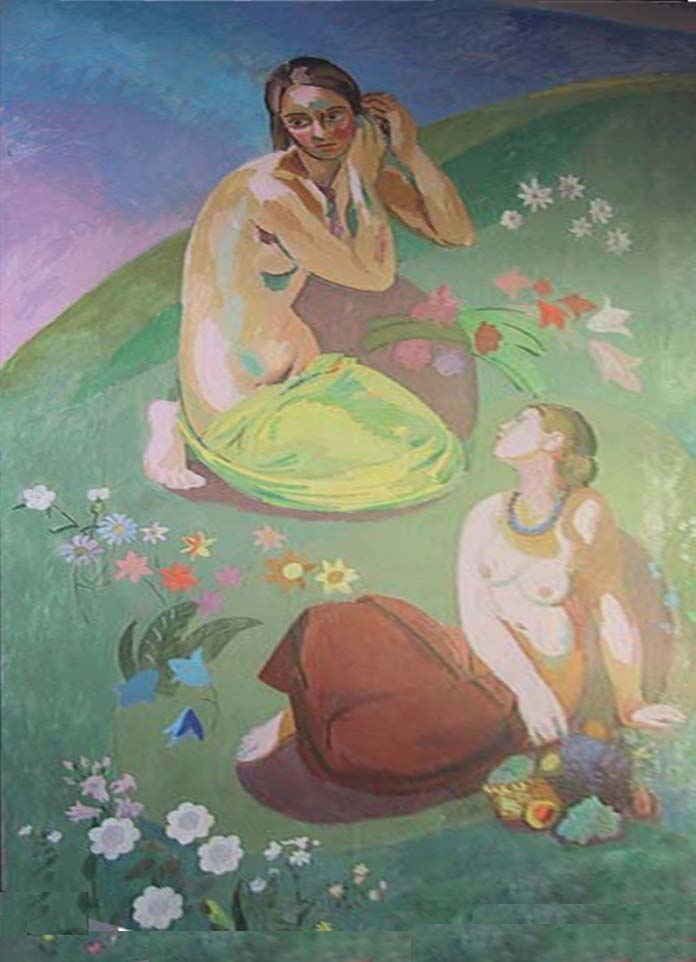
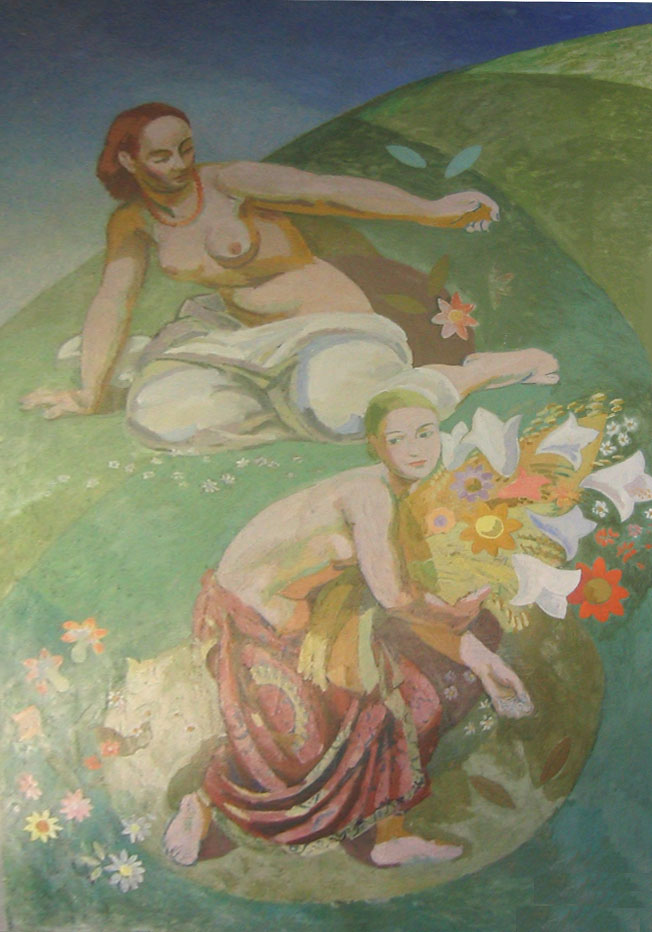
The two paintings intended for the spaces over the
side-fireplaces. The Flower Gatherers (left) and The Sheaf (right).
These paintings are still in a private collection today.
What would the room have looked like had Grant's
designs been accepted?
To recreate the room it was necessary to locate the
paintings and as many of the Grant's fabric-designs as possible. The paintings
were all sold in the 1970s to Alan Clark, the British politician, and most of them remain in
the hands of that estate today. Seguidilla was deteriorating and its size made
it impossible to display properly, and the Clarks unrolled it about once a year
on their lawn to view its condition. Sometime in the 1990s it was decided to cut
the painting into four pieces to make it usable. One of the four sections, the
cymbal-player, was in worse condition than the other three, and this was sold to
a private collector of Bloomsbury Group work in the United States, and he still
has it. Both he and the Clark estate were of great help to us in gathering
images for this article.
Not much survives of the fabrics designed by Grant for the
room. Just one sample was located by us in the Victoria and Albert museum in London
(pictured, left). This has been used in the renderings below.
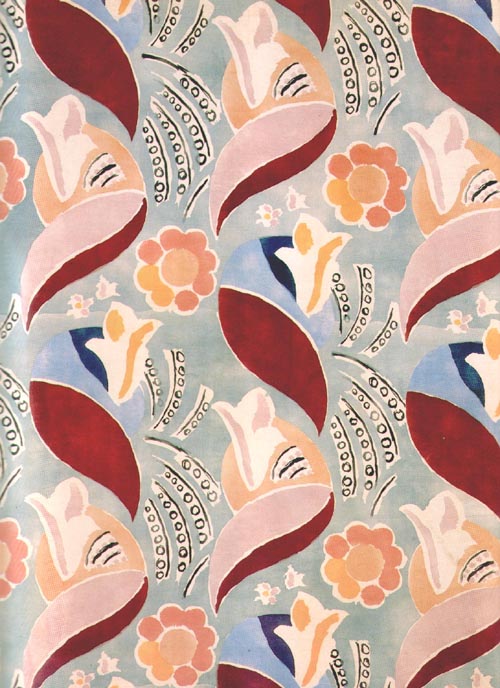 |
The Victoria and
Albert fabric-sample. What is not clear from our documentation to date is precisely how this particular fabric was intended to be used in the room? Was it for upholstery? Was it intended for use in window treatments? Was it an intended for use as an accent fabric for throw pillows on the large sofas? And what was the design of Duncan
Grant's carpets that were also rejected? What we can deduce from the combination of the paintings and the single fabric identified to date is the probable color scheme of the room. Mr. Taylor has surmised that
this fabric was used as an upholstery fabric, and he has selected a carpet
design that coordinates with it for his renderings of the room later in this
article. It is the author's hope to locate further samples of fabric and
carpet in the future. |
|
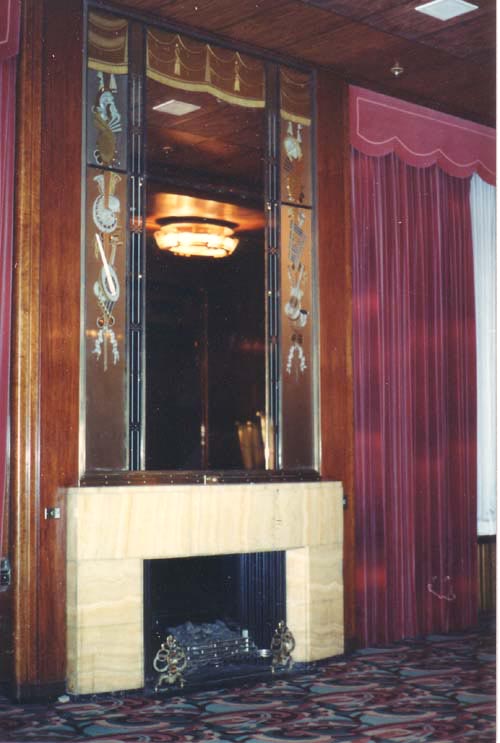 |
One of the mirrors mounted over the
side-fireplaces on the Queen Mary today. This photo was taken in the 1990s.
Move your mouse over the image to see what it would have looked like with
Duncan Grant's painting for this location in place. |
Below are renderings by Jeff Taylor
showing the room as it might have looked had
Duncan Grant's fabrics and paintings been used.
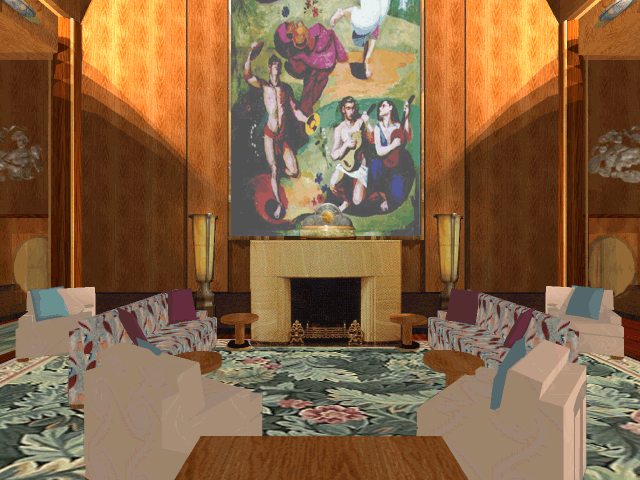
The forward end of the room showing
Seguidilla in place instead of Unicorns in Battle.
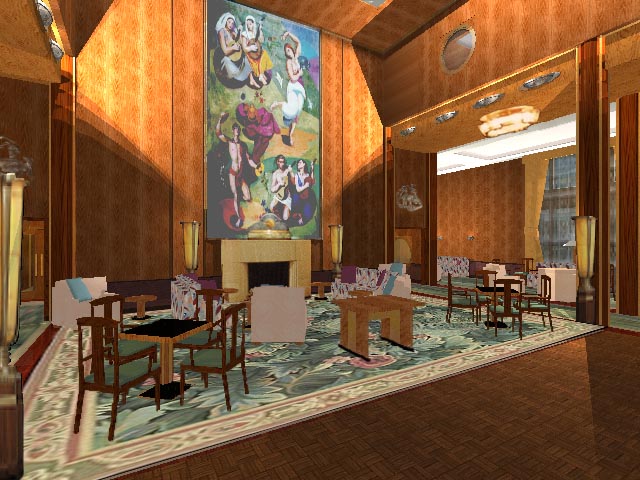
The fabric used for the renderings of
the sofas is that
found in the Victoria and Albert museum.
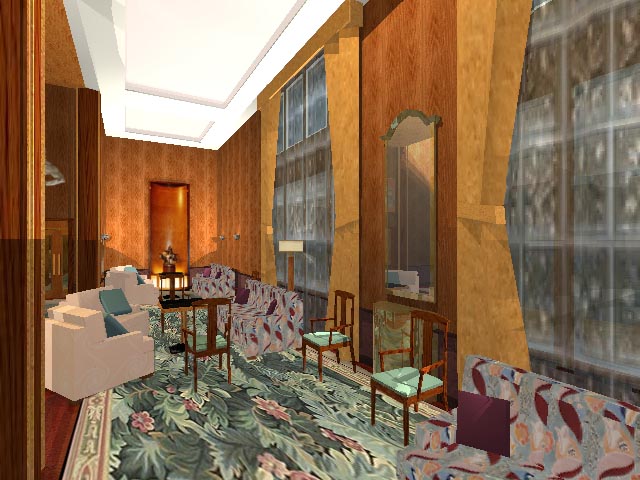
Looking forward on the starboard side of the
ship.
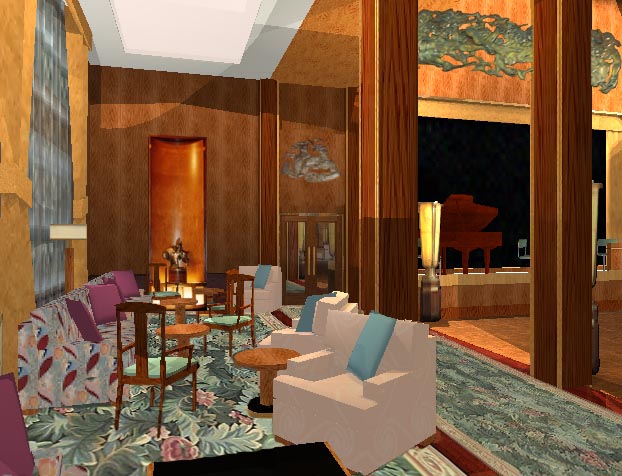
Looking aft on the starboard side of
the ship.
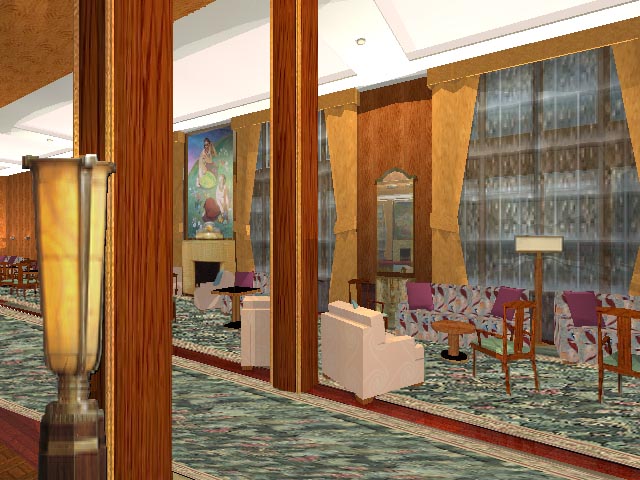
One of the side panels in place over
the fireplace.
Letters appeared in the newspapers of the time protesting at the
rejection of Grant's paintings and designs, but Cunard held fast and Grant's fee
of 1200 pounds was only paid on condition that he remained silent about the
affair. His reputation perhaps never recovered.
Had the paintings been used, the room would have had a very much
different appearance to that which greets the visitor today, which is that of an
invariably dark, formal room. It seems hard to believe today that the room was
used post-war as a ball room.
Traces of Grant's designs still remain in the
floral designs in the fireplaces, which seem to accompany those in his
paintings.
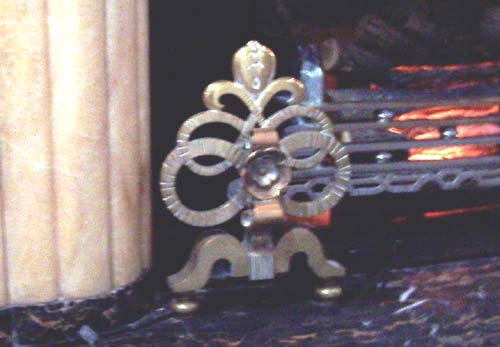
Floral design in the center of a
fireplace-chenet echoes the floral theme of Grant's intended decor.
The bronze reliefs over the four sets of doors and the stage -- of musicians -- provide an orchestra for the dancers in DG paintings. They make more sense with Duncan Grant's panels than what is there now.
 |
Bronze
reliefs over the stage and entrance doors to the Main Lounge. These seem
to echo designs in Duncan Grant's paintings rather than the replacement
fittings.
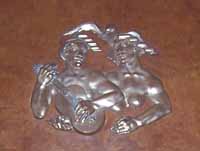
The fitting over the doors
(left) magnified. |
 |
 |
 Return to Index
by Deck
Return to Index
by Deck
 Return to
Index by Class of Accommodations
Return to
Index by Class of Accommodations
 Duncan Grant
(1885-1978) was a prominent member of the "Bloomsbury Group" - a collection of
friends with common ideas about philosophy and art. He lived for many years at
Charleston Farm with Vanessa Bell, a
property which still survives, alive with their artistic creations. Grant would
be paid 1200 pounds for his work on the Queen Mary - a vast sum in those days;
he was understandably delighted at this commission.
Duncan Grant
(1885-1978) was a prominent member of the "Bloomsbury Group" - a collection of
friends with common ideas about philosophy and art. He lived for many years at
Charleston Farm with Vanessa Bell, a
property which still survives, alive with their artistic creations. Grant would
be paid 1200 pounds for his work on the Queen Mary - a vast sum in those days;
he was understandably delighted at this commission.